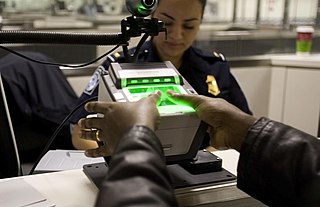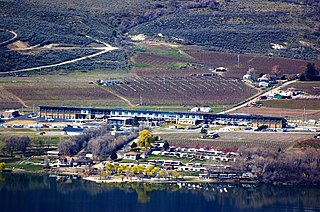
The United States Immigration and Naturalization Service (INS) was an agency of the U.S. Department of Labor from 1933 to 1940 and the U.S. Department of Justice from 1940 to 2003.

United States Visitor and Immigrant Status Indicator Technology is a U.S. Customs and Border Protection (CBP) management system. The system involves the collection and analysis of biometric data, which are checked against a database to track individuals deemed by the United States to be terrorists, criminals, and illegal immigrants. US-VISIT is accessed by 30,000 users from federal, state, and local government agencies. Upon Presidential approval of the 2013 Continuing resolution the US-VISIT program officially became the Office of Biometric Identity Management (OBIM), save for portions of the agency which performed overstay analysis being transferred into U.S. Immigration and Customs Enforcement and biometric Entry and Exit operations which became a part of U.S. Customs and Border Protection.

The United States Border Patrol (USBP) is a federal law enforcement agency under the United States Customs and Border Protection (CBP) and is responsible for securing the borders of the United States. According to its web site in 2022, its mission is to "Protect the American people, safeguard our borders, and enhance the nation’s economic prosperity."

The United States Customs Service was a federal law enforcement agency of the U.S. federal government. Established on July 31, 1789, it collected import tariffs, performed other selected border security duties, as well as conducted criminal investigations.

United States Customs and Border Protection (CBP) is the largest federal law enforcement agency of the United States Department of Homeland Security. It is the country's primary border control organization, charged with regulating and facilitating international trade, collecting import duties, as well as enforcing U.S. regulations, including trade, customs and immigration. CBP is one of the largest law enforcement agencies in the United States. It has a workforce of more than 45,600 federal agents and officers. It is headquartered in Washington, D.C.

INSPASS, or INS Passenger Accelerated Service System, was a program of the United States Immigration and Naturalization Service (INS) during the 1990s and early 2000s the purpose of which was to facilitate the entry of pre-screened low-risk travellers through immigration and customs at certain airports.

United States border preclearance is the United States Department of Homeland Security's (DHS) practice of operating prescreening border control facilities at airports and other ports of departure located outside of the United States pursuant to agreements between the United States and host countries. Travelers are subject to immigration and customs inspections by Customs and Border Protection (CBP) officers before boarding their transportation onward to the United States. Preclearance applies to all passengers regardless of their nationality or purpose of travel. Upon arrival, precleared passengers arrive in the United States as domestic travelers, but may still be subject to re-inspection at the discretion of CBP. This process is intended to streamline border procedures, reduce congestion at American ports of entry, and facilitate travel into airports that otherwise lack immigration and customs processing facilities for commercial flights.
The Customs-Trade Partnership Against Terrorism (C-TPAT) is a voluntary supply-chain security program led by U.S. Customs and Border Protection (CBP) focused on improving the security of private companies' supply chains with respect to terrorism. The program was launched in November 2001 with seven initial participants, all large U.S. companies. As of December 1, 2014, the program had 10,854 members. The 4,315 importers in the program account for approximately 54% of the value of all merchandise imported into the U.S.

Air and Marine Operations (AMO) is a federal law enforcement component within U.S. Customs and Border Protection (CBP), an agency of the United States Department of Homeland Security (DHS). AMO's mission is to protect the American people and nation's critical infrastructure through the coordinated use of air and marine assets to detect, interdict and prevent acts of terrorism and the unlawful movement of people, illegal drugs, and other contraband toward or across the borders of the United States. Air and Marine Operations Agents and Officers are endowed with the authority to enforce Title 8 and Title 19 (Customs) of the United States Code in addition to the general law enforcement powers bestowed upon federal law enforcement agents.

Goat Haunt is a region of Glacier National Park in Montana, United States. Goat Haunt is located at the head of Waterton lake which is fed by the Waterton River. The headwaters for the Waterton River are located South of Goat Haunt Ranger Station at unnamed lakes located slightly higher than Nashukin Lake. The Goat Haunt area shares Waterton Lake with Waterton Lakes National Park in Canada. This area is important for reinforcing the international nature of the Waterton-Glacier International Peace Park. It also provides hiking trails that connect the United States and Canada. The region provides wildlife habitats on both sides of the border. As a largely unspoiled natural area, visitors experience an area with few facilities or amenities, but with historical importance including Waterton Townsite and mountain passes used by American Indians.

The Office of Field Operations (OFO) is a federal law enforcement agency within the U.S. Customs and Border Protection (CBP) responsible for managing United States customs operations at 20 Field Operations offices, 328 ports of entry, and 16 pre-clearance stations in Canada, Ireland, the UAE, and the Caribbean. Headed by an Executive Assistant Commissioner, OFO directs the activities of more than 27,000 employees, including more than 22,000 CBP Officers and Agriculture Specialists. CBP Office of Field Operations is the largest component in CBP.
The Port Passenger Accelerated Service System (PORTPASS) was a suite of programs of the former U.S. Immigration and Naturalization Service (INS), including:

The Secure Electronic Network for Travelers Rapid Inspection (SENTRI) provides expedited U.S. Customs and Border Protection (CBP) processing, at the U.S.-Mexico border, of pre-approved travelers considered low-risk. Voluntarily applicants must undergo a thorough background check against criminal, customs, immigration, law enforcement, and terrorist databases; a 10-fingerprint law enforcement check; and a personal interview with a CBP Officer. The total enrollment fee is $122.50, and SENTRI status is valid for 5 years.
SBInet, the Secure Border Initiative Network, was a program initiated in 2006 for a new integrated system of personnel, infrastructure, technology, and rapid response to secure the northern and southern land borders of the United States. It was a part of Secure Border Initiative (SBI), an overarching program of the United States Department of Homeland Security (DHS) to organize the four operating components of border security: U.S. Customs and Border Protection (CBP), U.S. Immigration and Customs Enforcement, United States Citizenship and Immigration Services, and the United States Coast Guard. DHS announced the program's cancellation on Jan. 14, 2011.

The Remote Video Inspection System (RVIS) was deployed by United States in the late 1990s at select low-traffic border entry points from Canada. The system allowed passport and customs inspections to be conducted remotely, so that low-risk travelers could enter the country during hours that the border station did not have on-site staff. The system was successfully deployed at a number of entry points, in six different states. RVIS was discontinued following the September 11 attacks.

The Morses Line Border Crossing connects the towns of Saint-Armand, Quebec with Franklin, Vermont on the Canada–US border. It is reached by Vermont Route 235 on the American side and by Quebec Route 235 on the Canadian side.

The Oroville–Osoyoos Border Crossing connects the city of Oroville, Washington and the town of Osoyoos, British Columbia on the Canada–US border. U.S. Route 97 on the American side joins British Columbia Highway 97 on the Canadian side.

The Scobey–Coronach Border Crossing connects the towns of Scobey, Montana and Coronach, Saskatchewan on the Canada–US border. Montana Highway 13 on the American side joins Saskatchewan Highway 36 on the Canadian side. An airport with a grass runway that straddles the border is located on the east side of this crossing.
Container port design process is a set of correlated practices considered during container port design, aiming to transfer general business mission into detailed design documents for future construction and operation.

The Naco, Arizona Border Station has been in existence for more than 100 years. The historic Adobe-style border station built in 1937 still stands and serves as CBP office space. A new border inspection station was built in adjacent space in 1994 by the General Services Administration. At one time, trains used to cross the border here as well, but train service ended early in the 20th Century. The building was listed on the National Register of Historic Places in 1991.















